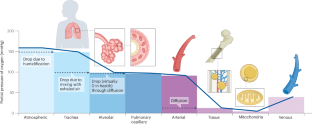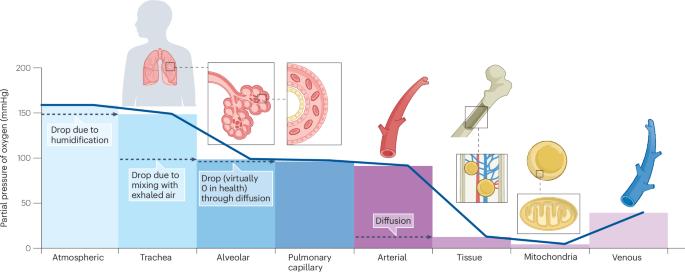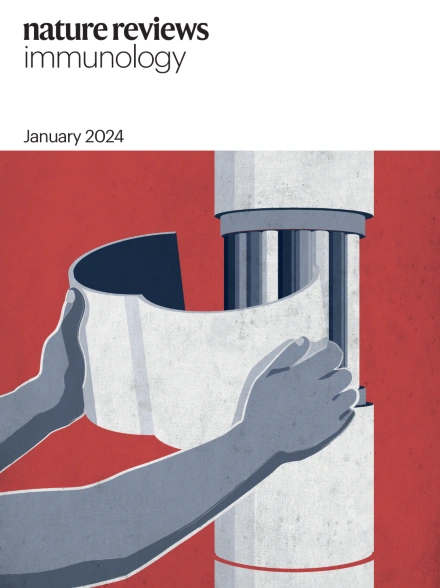氧合如何影响免疫反应:生理缺氧和病理缺氧的新作用
IF 67.7
1区 医学
Q1 IMMUNOLOGY
引用次数: 0
摘要
大多数真核生物的生存都需要氧气,而随着多细胞复杂性的增加,氧气的可用性和输送率在复杂生物体的各个组织中也各不相同。在人体中,健康组织的氧气梯度明显不同,从骨髓(我们的造血干细胞所在之处)的低氧环境到肺及其肺泡,肺及其肺泡是人体含氧量最高的区域之一。因此,当免疫细胞从骨髓转移到外周器官以发挥其效应功能时,需要适应不同的氧气供应。在炎症期间,由于组织灌注的改变和细胞活动的增加,氧梯度的变化会更加明显。因此,在组织稳态和疾病状态下考虑氧合对形成免疫反应的影响非常重要。在这篇综述中,我们将探讨生理性缺氧(物理性缺氧)和疾病相关性缺氧(细胞需氧量大于供氧量)与免疫细胞功能的相关性,讨论缺氧与组织稳态、炎症、感染、癌症和疾病免疫疗法中免疫反应的相关性。本文章由计算机程序翻译,如有差异,请以英文原文为准。



How oxygenation shapes immune responses: emerging roles for physioxia and pathological hypoxia
Most eukaryotes require oxygen for their survival and, with increasing multicellular complexity, oxygen availability and delivery rates vary across the tissues of complex organisms. In humans, healthy tissues have markedly different oxygen gradients, ranging from the hypoxic environment of the bone marrow (where our haematopoietic stem cells reside) to the lungs and their alveoli, which are among the most oxygenated areas of the body. Immune cells are therefore required to adapt to varying oxygen availability as they move from the bone marrow to peripheral organs to mediate their effector functions. These changing oxygen gradients are exaggerated during inflammation, where oxygenation is often depleted owing to alterations in tissue perfusion and increased cellular activity. As such, it is important to consider the effects of oxygenation on shaping the immune response during tissue homeostasis and disease conditions. In this Review, we address the relevance of both physiological oxygenation (physioxia) and disease-associated hypoxia (where cellular oxygen demand outstrips supply) for immune cell functions, discussing the relevance of hypoxia for immune responses in the settings of tissue homeostasis, inflammation, infection, cancer and disease immunotherapy. Oxygen levels vary throughout the body and immune cells must adapt to these changes, both during homeostasis and in disease. Here, the authors discuss the impact of physiological subatmospheric oxygen levels (physioxia) as well as disease-related hypoxia on immune cell responses. They consider the therapeutic relevance of understanding how oxygenation affects immune responses in various diseases, including tuberculosis, COVID-19 and cancer.
求助全文
通过发布文献求助,成功后即可免费获取论文全文。
去求助
来源期刊

Nature Reviews Immunology
医学-免疫学
CiteScore
93.40
自引率
0.40%
发文量
131
审稿时长
6-12 weeks
期刊介绍:
Nature Reviews Immunology is a journal that provides comprehensive coverage of all areas of immunology, including fundamental mechanisms and applied aspects. It has two international standard serial numbers (ISSN): 1474-1733 for print and 1474-1741 for online. In addition to review articles, the journal also features recent developments and new primary papers in the field, as well as reflections on influential people, papers, and events in the development of immunology. The subjects covered by Nature Reviews Immunology include allergy and asthma, autoimmunity, antigen processing and presentation, apoptosis and cell death, chemokines and chemokine receptors, cytokines and cytokine receptors, development and function of cells of the immune system, haematopoiesis, infection and immunity, immunotherapy, innate immunity, mucosal immunology and the microbiota, regulation of the immune response, signalling in the immune system, transplantation, tumour immunology and immunotherapy, and vaccine development.
 求助内容:
求助内容: 应助结果提醒方式:
应助结果提醒方式:


